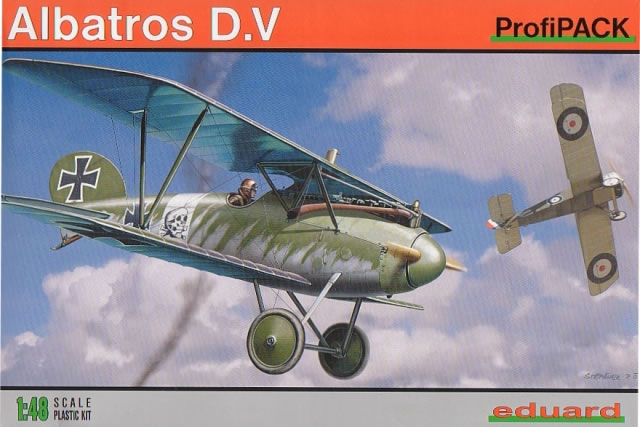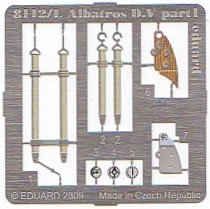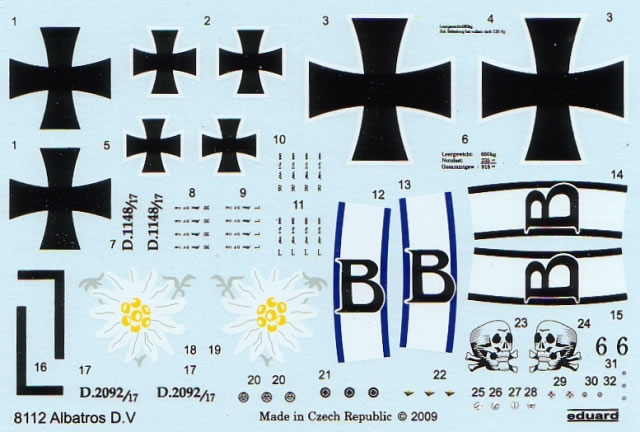|
Albatros D.V ProfiPACK

Eduard, 1/48 scale
S
u m m a r y |
| Catalogue Number: |
Eduard Kit No. 8112 - Albatros D.V “ProfiPACK” |
| Scale: |
1/48 |
| Contents and Media: |
60 parts in tan coloured plastic; 73 photo-eched parts; markings for four aircraft |
| Price: |
USD$24.95 available online from Eduard
and hobby retailers worldwide |
| Review Type: |
FirstLook |
| Advantages: |
Crisp detail; blemish-free parts; accurate outline; both coloured and standard photo-etched parts; well thought out masking set and decals in perfect register with thin carrier film. |
| Disadvantages: |
Those short undercarriage legs |
| Conclusion: |
Another welcome outing for the Albatros D.V. Excellent use is made of the included photo-etched parts which are an ideal embellishment for this aircraft. The well catered for decal sheet means plenty of items for the spares box and the printing as usual is exceptional. The plastic parts have stood the test of time but replacement undercarriage legs would not go amiss. |
Reviewed by
Rob Baumgartner

Eduard's 1/48 Albatros D.V Profipack is available online from Squadron.com
Eduard’s Albatros D.V has always been a favourite amongst WWI aircraft fans. This latest incarnation takes the form of a “ProfiPACK” and provides another collection of colourful subjects.
In the box are two tan coloured sprues holding a total of 60 parts. The passing years have not diminished the quality of these mouldings. Each piece is still essentially flash-free with no pin or sink marks being visible on the finished model.
Also included are a couple of frets of photo-etched items. Of the 73 pieces available, 8 are pre-coloured to accommodate the seatbelts, instrument faces and wooden side panel. A set of masks round out the package and these are of the much favoured “tape” variety.
Construction starts will the cockpit and there is plenty to add here. The fuselage interior contains moulded on structural details to which are added a collection of smaller essentials. These include the magneto and associated switch, sparking control, hand operated air pump, water pump greaser and mounting block for the various fuel/air selector valves.
 Larger items such as the ammunition and cartridge belt bins are also catered for and the instruments come courtesy of either decals or the aforementioned coloured photo-etched fret.
This is rounded off by the usual fare such as seat, control column, rudder bar and floor. Larger items such as the ammunition and cartridge belt bins are also catered for and the instruments come courtesy of either decals or the aforementioned coloured photo-etched fret.
This is rounded off by the usual fare such as seat, control column, rudder bar and floor.
A 5-piece Mercedes engine completes the interior which fits reasonably well between the fuselage halves. A little sanding of the bulkheads will help ease the two sides together.
The original kit was designed around Ian Stair’s general arrangement drawings and the outlines of the various components match these very well. An error did slip into these otherwise excellent plans and this relates to an extra inspection hatch which Eduard has faithfully reproduced. This is found on the lower part of the starboard side just behind the rearmost vent. It is easy to sand off however with no loss of detail to the surrounding area.
An updated set of Ian’s plans saw another anomaly appear where the port carburetor access hatch is seen located much lower than it should be. Fortunately Eduard didn’t replicate this.
The misplacement of the footstep is corrected by a photo-etched replacement and kudos to the manufacturer for rectifying this.
Both upper and lower wings are done as single piece affairs. Thus there is no messing around with dihedrals which greatly aids the building process. The ribs are represented by subtle ridges and the trailing edges are commendably thin.
The purist will no doubt add the missing “washout”, which was seen at the extremities of the upper flying surfaces.
There is one area that does need serious addressing and that is the undercarriage. The legs are much too short which gives the finished model a squatting appearance. Fixing the problem will be problematical but not impossible. It would be nice if future editions of this aircraft had an additional small sprue with corrected items.
The rest of the supplied photo-etched parts really spruce up the exterior look of the aircraft. There are machine gun jackets, aileron control horns (with covers), radiator shutters, cable entries, plates, cockpit valve selectors, to mention but a few.
To ease the painting process, a very handy sheet of precut masks is provided. This is used for the wheels, Jasta 5 tail outline, metal engine panels and radiator.
Marking Options
Decals are included for 4 aircraft, each significantly different from the other in terms of colour scheme and markings. All items were superbly printed with everything in perfect register. The carrier film is thin and has been kept to a minimum.

There are a few bonuses on the sheet and these are found in the form of propeller logos, stencil data for the struts, and a myriad of instrument faces.
- Ltn. Kurt Monnington, Jasta 15, 1917
Having joined Jasta 15 in 1917, Monnington became part of Jasta 18 after the mass pilot transfer in March 1918. He managed 8 victories with this unit which included 5 DH9 aircraft.
- Ltn, Walter Böning, Jasta76b, early 1918
Böning was a 17 victory ace that served with both Jasta 19 and 76b. His combat career ended when on 31 may 1918 he collided with Vzfw Georg Markert. This distraction allowed both pilots to be jumped by Camels of 70 Sqn. Markert was killed but Boning survived with an injury and did not see any more action.
- Ltn. Hans Adam, Jasta 6, summer 1917
Having been assigned to Jasta 34 on 2 March 1917, Adam soon opened his account with victory over a Caudron that same month. He scored twice more before transferring to Jasta 6 where he brought his total to 21. Nine days after his final success he lost his life in a combat with Lt. K B Montgomery in Camel B3929.
- Ltn. Wilhelm Lehmann, Jasta 5, 1918
This flamboyant aircraft is typical of Jasta 5’s Albatros fighters. Lehmann was acting CO of Jasta 5 from 31 December 1917 until 14 January 1918. He became Commander on 12 May 1918 but lost his life in combat on 26 June 1918 having not troubled the scorers.
This is the faithful Eduard kit of years gone by and it still looks as though it was released yesterday.
The addition of the coloured and non-coloured photo-etched parts brings the kit up to another level and makes it a real eye-catcher. Assembly is an easy matter and the only real problem relates to the “sit” of the aircraft. For those that are concerned about such things, it can be put right with a little patience but some modeling experience will be necessary.
The type’s racy contours and variety of colour schemes will ensure that this is a popular release for all modellers of WWI aircraft.
Thanks to Eduard for the sample
Review Text Copyright © 2009 by Rob Baumgartner
Page Created 11 November, 2009
Last updated
11 November, 2009
Back to HyperScale Main Page
Back to Reviews Page

|
